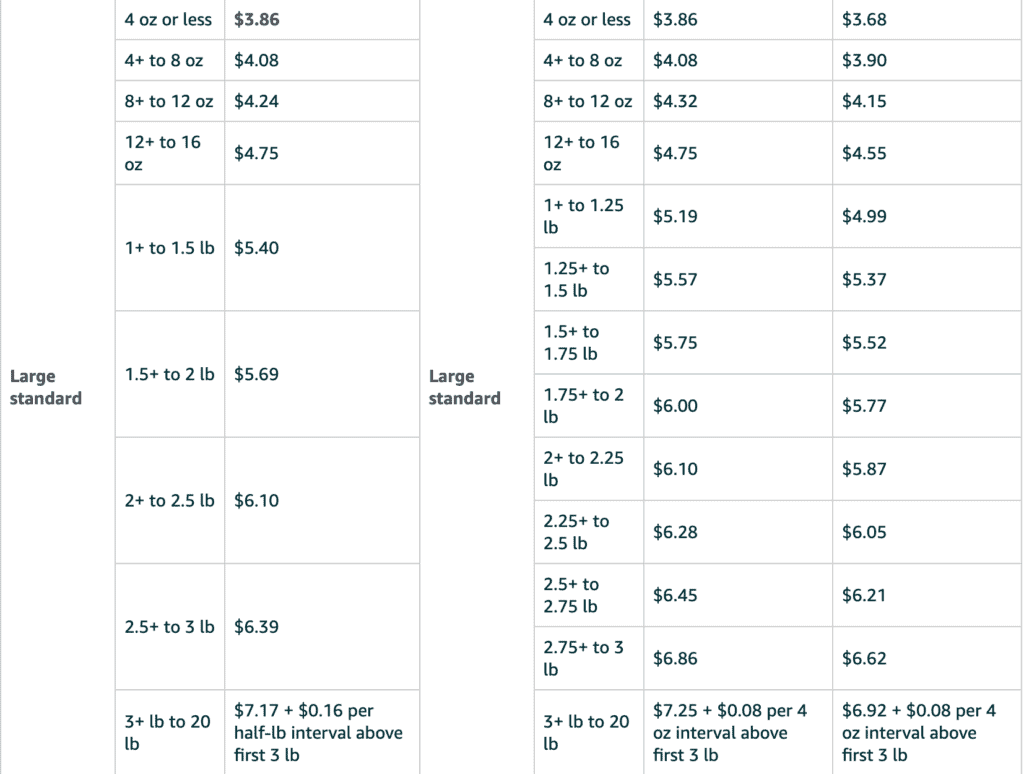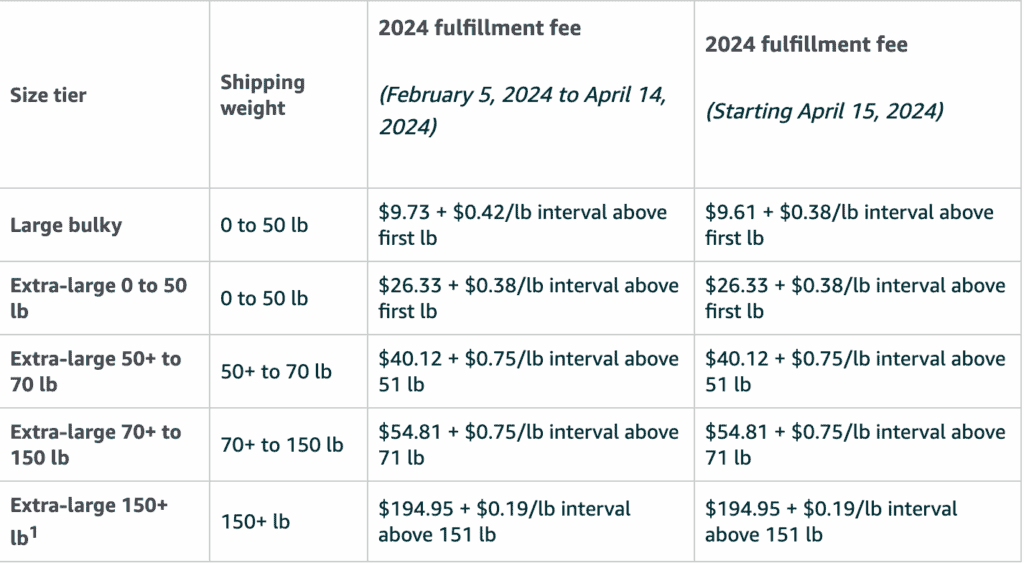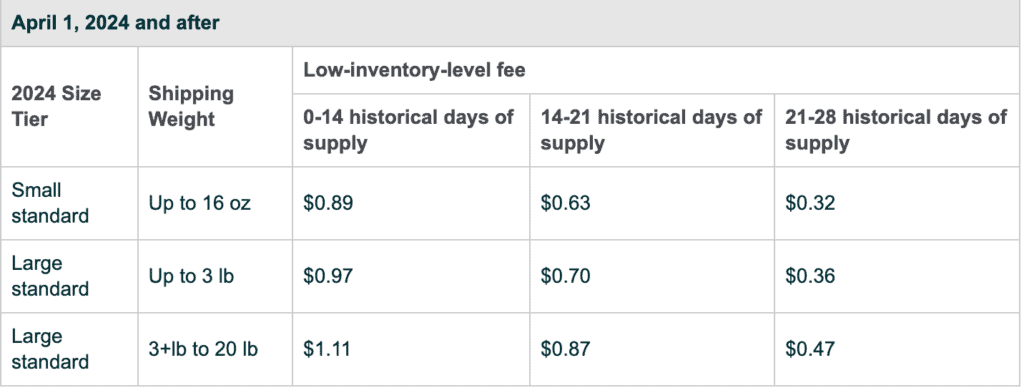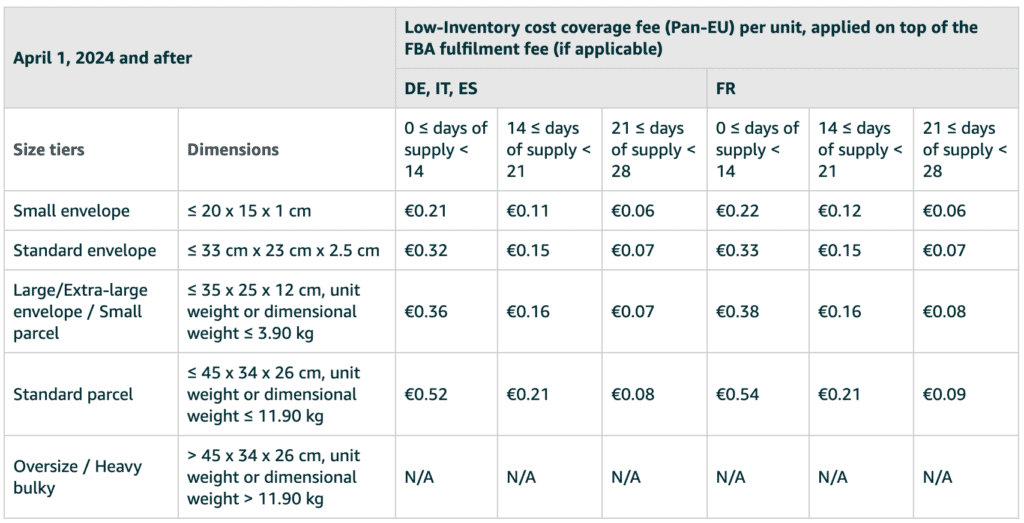Amazon has just dropped a bombshell announcement – the eCommerce giant is implementing its most significant FBA fee changes to date. Strap in, as we unravel the layers of this fee adjustment puzzle, dissecting how each update may impact...
Amazon has just dropped a bombshell announcement – the eCommerce giant is implementing its most significant FBA fee changes to date. Strap in, as we unravel the layers of this fee adjustment puzzle, dissecting how each update may impact your margins.
2024 FBA Fee Changes at a Glance
In a corporate blog post dated December 5, 2023, Dharmesh Mehta, Vice President, Worldwide Selling Partner Services, said Amazon is implementing the following referral and FBA fee changes in 2024:
Commencing on March 1, 2024, an inventory placement fee will be imposed on each item shipped into FBA, ranging from $0.21 to $0.68 per unit for standard size items and $2.16 to $6.00 for oversize items. Effective April 15, 2024, Amazon is reducing FBA fees for most items, notwithstanding the introduction of the new placement fees which will actually create a net increase overall. Starting April 1, 2024, FBA sellers will be subject to low-inventory-level fees for standard size items that have less than 28 days of inventory. So, apart from incurring overage fees for excess inventory at Amazon, sellers will also have to pay a fee if their inventory stored at FBA falls below a certain threshold. Effective January 15, 2024, Amazon is implementing a reduction in referral fees for apparel products with prices below $20. Amazon seems to be replacing the “Oversize” size tiers by rebranding them “Large Bulky-size”.Inbound Inventory Placement Fee
Applicable to both standard and large bulky-sized items, this fee covers the cost of transporting your shipments from an initial receiving center to several fulfillment centers (FCs) across the country. Bringing inventory closer to urban centers allows Amazon to provide faster delivery speeds at a lower outbound transportation cost.
While this change may benefit Amazon and customers, it could increase seller inbound fees significantly. Then again, it may be that in some instances, only needing to ship to one single location rather than multiple could make up for the fee in actual shipping cost savings.
When shipping inventory to a single location, expect to pay $0.21 to $0.68 per unit fee for standard size and $2.16 to $6.00 for large bulky products. The impact of this fee adjustment could be extremely rough on sellers who are already facing major profit erosion due to all of the FBA fee increases made earlier this year.
Note: Amazon is replacing Inventory Placement Service (IPS) with this new inbounding program on March 1, 2024, essentially subjecting most sellers to additional shipping costs instead of giving them the option to sign up for a paid service like IPS.
Standard Size Placement Fee Rates (starting March 1, 2024)
| Size | Weight | Premium FBA Inbound Placement Service Fee (send to a single location) | Discounted FBA Inbound Placement Service (Send to multiple locations) |
| Small standardMax 15x12x0.75 inches | 16 oz or less | $0.21-$0.30 | Receive up to 100% discount based on number of shipments and inbound locations. |
| Large standardMax 18x14x8 inches | 12 oz or less | $0.23-$0.34 | |
| 12+ oz to 1.5 lb | $0.27-$0.41 | ||
| 1.5+ lb to 3 lb | $0.32-$0.49 | ||
| 3+ lb to 20 lb | $0.42-$0.68 |
Large Bulky Size Placement Fee Rates (starting March 1, 2024)
| Size | Weight | Premium FBA Inbound Placement Service Fee (send to a single location) | Discounted FBA Inbound Placement Service (Send to multiple locations) |
| Large Bulky Size Max 59x33x3 inches | 5 lb or less | $2.16 to $2.67 | Receive up to 100% discount based on number of shipments and inbound locations. |
| 5+ lb to 12 lb | $2.55 to $3.15 | ||
| 12+ lb to 28 lb | $3.19 to $3.95 | ||
| 28+ lb to 42 lb | $4.13 to $5.11 | ||
| 42+ to 50 lb | $4.85 to $6.00 |
These charges apply when sending shipments to a single FC. Those who want to send their products to multiple inbound FCs themselves may opt for Amazon’s discounted inventory placement service for a reduced fee or no fee, depending on the number of shipments, current inventory levels at FBA, and target inbound locations.
Pro tip: When creating a shipping plan, compare the total cost of sending in 3 shipments (i.e., Texas, California, and Florida) versus the cost of 1 shipment to see which is more profitable for your business. Your account will then be charged a fee 45 days after receipt of your inventory by Amazon.
Alternatively, you may sign up for Amazon Warehousing and Distribution (AWD), the retailer’s low-cost upstream bulk storage solution, to completely avoid these inbound placement service fees. However, do so cautiously, as sellers have shared mixed reviews on this service, with some having quite a bit of trouble with lost inventory and difficulty transferring stock to non-Amazon locations.
If you’re mostly shipping oversized items, consider using Amazon Global Logistics to save on costs. This move makes one wonder whether the new inbounding program is just another tactic employed by Amazon to strong-arm sellers into putting all their eggs in one fulfillment network, or, conversely, to push sellers to take on the burden of distribution themselves.
Related: The Covert Amazon Program that could be Costing You Thousands
Lower FBA Fulfillment Fees
Shifting from a national fulfillment model to 8 interconnected regional fulfillment networks has a few benefits, one of which is lower outbound transit cost – savings that Amazon can pass on to sellers (which are unfortunately offset by the inventory placement fee introduction).
Effective April 15, 2024, Amazon will decrease FBA fees for standard-sized products by $0.20 per unit and for Large Bulky-sized products by $0.61 per unit on average.



For some sellers, these fee decreases barely make a dent in offsetting the impact of the newly introduced receiving fees. In that case, be sure to take advantage of any ongoing fulfillment fee discount promo or conduct an inventory profit audit to minimize profit loss and stay ahead of fees.
See the updated FBA Fulfillment Fee Rates here.
Low-Level Inventory Fee
In Mehta’s announcement on December 5th, he explained that the new fee for standard-sized items “applies if you carry consistently low levels of inventory relative to unit sales, as this inhibits our ability to distribute products across our network, degrading delivery speeds and increasing our shipping costs. Sellers can avoid this fee by maintaining more than four weeks of inventory relative to sales. These fees will apply starting April 1, 2024.”
Let’s make it very clear that this is a fulfillment fee related to total days of supply at FBA. It is not a storage fee. This means that you will only be charged when you sell the stock. This fee kicks in upon fulfillment of the units being penalized.
The introduction of Low-Level Inventory Fee seems directly linked to Amazon’s decision to restructure FBA. Instead of maintaining a nationwide fulfillment network, the company has transitioned to operating eight regional networks, each functioning independently to enhance delivery speed.
However, Jassy’s shareholder letter regarding this shift overlooked addressing the repercussions for sellers utilizing FBA for inventory storage and fulfillment. Consequently, it remains uncertain whether sellers will need to divide inbound shipments more frequently. What is evident now is that they will bear the cost of decentralizing the network, with the specifics yet to be clarified.
“Maintaining sufficient inventory levels also enables us to place inventory closer to customers across our network, reducing costs to fulfill orders. In cases where you have low inventory levels, this drives transportation costs higher, and we will introduce fees to align with these underlying costs. Where your actions reduce our costs of fulfillment by maintaining healthy inventory levels, you will see lower fees for these items.”
Simply put, maintaining less than four weeks of inventory in FBA will result in higher costs for sellers—specifically, charges ranging between $0.32 – $1.11 per unit.

The implementation of the new low-inventory fee requires sellers to have increased visibility into their inventory so that they can quickly get rid of unprofitable products and keep their best sellers in stock. Some sellers might even be tempted to temporarily reduce advertising efforts or increase pricing to circumvent low-inventory fees in case of unforeseen surges in demand, potentially averting a low stock period or reducing the number of units sold and subject to this added fulfillment cost. The new low-inventory fee makes forecasting inventory demand with razor-sharp accuracy and efficient inventory management more important than ever.
Here’s a glimmer of positive development. To help you maintain sufficient inventory levels, Amazon will reduce the non-peak monthly storage fees for standard-size products by an average of $0.09 per cubic foot, from an average of $0.87 per cubic foot to $0.78 per cubic foot, from January-September. Monthly storage fees for non-standard-sizes will remain the same, however. This update will apply on April 1, 2024.

Additional Changes
Amazon is implementing further changes, which encompass:
A reduction in referral fees for apparel products The introduction of a fulfillment fee discount for eligible items enrolled in the Ships in Product Packaging (SIPP) program Expansion of “returns processing fees” to all categories for products with elevated return rates (while the existing returns processing fees for apparel and shoes will maintain their current average rates). The implementation of new rates and benefits for Supply Chain by Amazon, an end-to-end solution to swiftly move your inventory from suppliers to customers globally. Update to the fees for Amazon Global Logistics, Partnered Carrier Program, and Amazon Warehousing & Distribution. Annual updates to Storage Utilization Surcharge, Removal, Disposal, Aged Inventory, Prep, and Inbound Defect fees.In sum, Amazon routinely implements annual fee hikes, but the intricacy of the latest fee adjustments is unprecedented. Some sellers may have a hard time completely grasping the financial and operational repercussions of these fee hikes, along with the inevitable need for subsequent price adjustments, while others may opt to overlook these fee increases due to their complexity, leading to a gradual decline of profit margins.
Some of the mentioned fee updates have yet to be revealed. We will continue to inform sellers on the changes as they roll out and will update our Amazon Fee Stack white paper accordingly. There, we will be doing a deep dive into all of these fees and providing more insights into how each of them work and their potential impact on sellers.
Related: Minimize the Impact of FBA Fee Increases on Your Margins, Restore Profitability in Your Business, Amazon FBA Calculator to Optimize FBA Size Tier Fees












